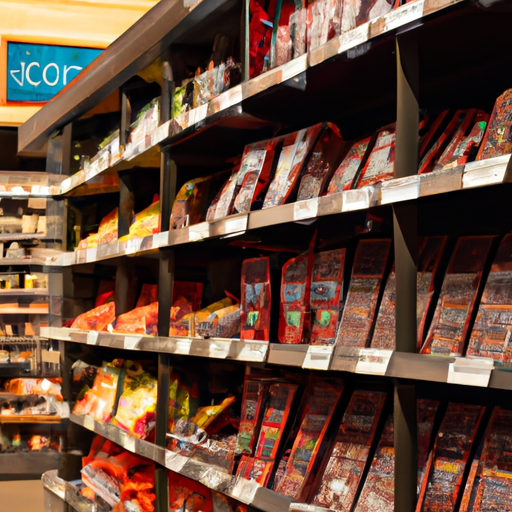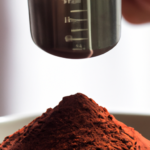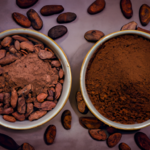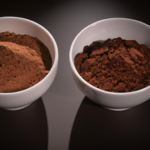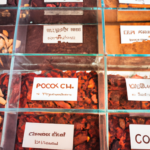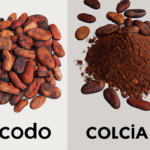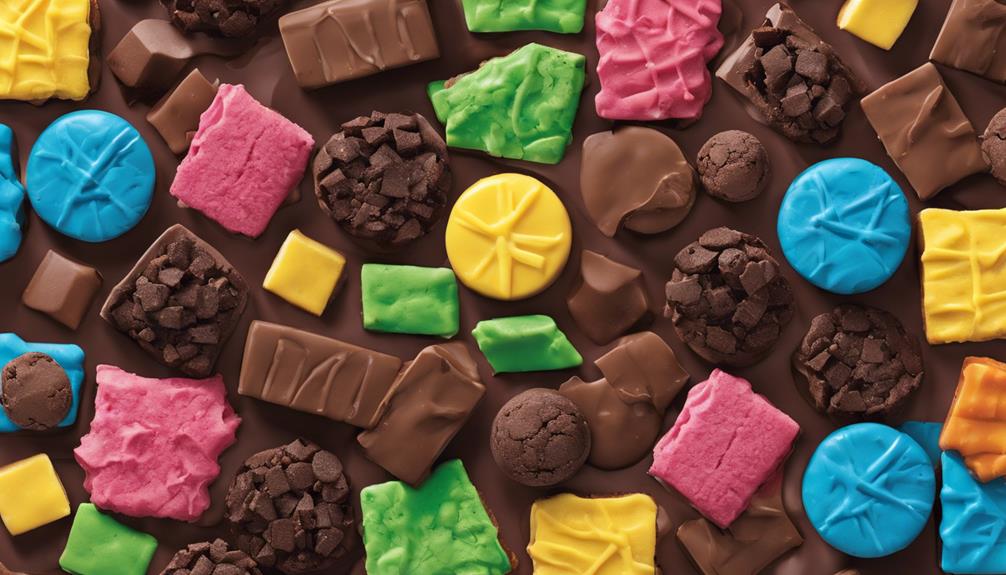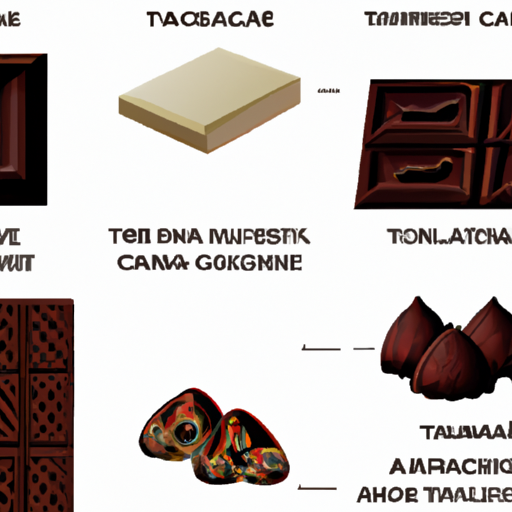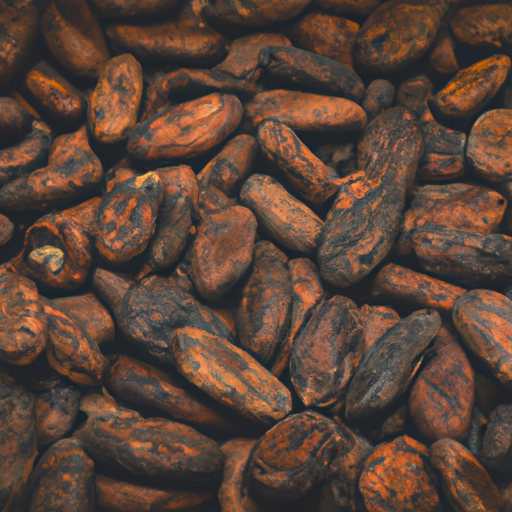As a lover of all things chocolate, I often find myself standing in the baking aisle, pondering the difference between baking cocoa and raw cacao. It’s a question that has consumed my curiosity for quite some time. So, I delved into the world of chocolate, investigating the origins, nutritional composition, culinary uses, processing methods, and even health considerations of these two cocoa products.
What I discovered was a fascinating tale of flavors, textures, and endless possibilities in the kitchen.
Imagine a rich, velvety chocolate cake, its aroma filling the air as it bakes in the oven. Now, picture that same cake infused with the intense, complex flavors of raw cacao. The difference between baking cocoa and raw cacao lies not only in their origins and processing methods but also in the unique taste and texture they bring to our culinary creations.
Join me on this journey as we explore the nuances that set baking cocoa and raw cacao apart, and uncover the secrets to elevating our chocolatey delights to new heights.
Key Takeaways
- Baking cocoa is more affordable and widely available compared to raw cacao.
- Baking cocoa is processed at high temperatures, resulting in a refined and smoother flavor, while raw cacao is minimally processed, preserving its natural taste and texture.
- Raw cacao has a slightly bitter and intense flavor with a coarser texture, while baking cocoa has an intense and bitter taste.
- Raw cacao is praised for its health benefits, including antioxidants, fiber, magnesium, and iron, and retains more natural nutrients compared to baking cocoa.
The Origins of Baking Cocoa and Raw Cacao
The origins of baking cocoa and raw cacao can transport you to lush tropical rainforests. The rich flavors and aromas of these ingredients come to life in these culinary traditions. These traditions have deep cultural significance and date back centuries to ancient civilizations like the Mayans and Aztecs.
Both baking cocoa and raw cacao are derived from the cacao tree, which is native to Central and South America. The cacao beans are harvested, fermented, and dried before being processed into cocoa powder or left in their raw form.
While baking cocoa is typically roasted at high temperatures, raw cacao is made from unroasted beans. This process preserves more of its natural nutrients and flavors.
Now, let’s delve into the nutritional composition of these two delightful ingredients.
Nutritional Composition
Indulging in the rich flavors of decadent desserts made with raw cacao or baking cocoa offers a distinct variation in their nutritional profiles. Raw cacao, derived from the seeds of the Theobroma cacao tree, is minimally processed to preserve its natural nutrients. It contains a higher concentration of antioxidants, minerals, and fiber compared to baking cocoa. On the other hand, baking cocoa is made by pressing raw cacao beans to remove the cocoa butter, resulting in a lower fat content. The processing methods differ greatly between the two, impacting their nutritional composition. To illustrate this, here is a table comparing the nutritional values of raw cacao and baking cocoa:
| Nutrient | Raw Cacao | Baking Cocoa |
|---|---|---|
| Antioxidants | High | Moderate |
| Fiber | High | Low |
| Fat | Moderate | Low |
| Minerals | Rich | Minimal |
Understanding the origins and processing methods of raw cacao and baking cocoa provides valuable insights into their nutritional content. Moving forward, let’s explore their diverse culinary uses.
Culinary Uses
Exploring the culinary uses of raw cacao and baking cocoa opens up a world of delicious possibilities.
Raw cacao can be used in a variety of culinary techniques. It can be used as a topping for desserts, adding a rich and intense flavor. It can also be added to smoothies, giving them a deep and chocolatey taste. Surprisingly, raw cacao can even be used in savory dishes like mole sauce, adding a unique and complex flavor profile.
On the other hand, baking cocoa is specifically processed for baking purposes. It is often used in recipes that require a more mild and balanced chocolate flavor. Baking cocoa is a staple ingredient in making cookies, cakes, and other baked goods. It provides a classic chocolate taste that is loved by many.
If you run out of raw cacao or baking cocoa, you can substitute one for the other. However, it’s important to note that the flavor and texture may differ slightly. So, it’s always best to use the recommended ingredient if you want to achieve the desired taste and consistency.
Now, let’s dive into the different processing methods used for raw cacao and baking cocoa.
Processing Methods
When it comes to processing methods, there are distinct differences between how baking cocoa and raw cacao are made.
Baking cocoa is made by roasting cocoa beans, removing the cocoa butter, and then grinding the remaining solids into a powder.
On the other hand, raw cacao is made by cold-pressing unroasted cocoa beans, which retains more of the natural nutrients and flavors.
These different processing methods have a direct impact on the flavor and texture of the final product, with baking cocoa being more intense and bitter, while raw cacao has a more complex and fruity taste.
How baking cocoa is made
To understand how baking cocoa is made, imagine yourself transported back in time to the cocoa processing factory, where the magical transformation from raw cacao to rich, flavorful baking cocoa takes place. The production process involves several key steps:
- Harvesting: The cocoa beans are carefully hand-picked from the cocoa tree pods.
- Fermentation: The beans are placed in large containers to undergo fermentation, which develops the complex flavors.
- Drying: After fermentation, the beans are spread out to dry under the sun or in special drying rooms.
- Roasting: The dried beans are roasted to bring out their distinct aroma and deepen the flavors.
- Grinding: Finally, the roasted beans are ground into a fine powder, creating the baking cocoa we all know and love.
Understanding the production process helps us appreciate the quality differences between baking cocoa and raw cacao.
Moving on to the process of making raw cacao…
The process of making raw cacao
The journey to creating raw cacao begins with carefully selecting and hand-picking the finest cacao beans from the cocoa tree pods. These beans are then fermented for a few days to develop their unique flavor profile. After fermentation, the beans are dried in the sun, enhancing their rich taste. Once dried, the outer shell of the beans is removed, leaving behind the cacao nibs. The nibs are then ground into a paste, which is known as raw cacao. This paste can be used as is or further processed into powder or butter. Raw cacao is known for its numerous health benefits, including being a rich source of antioxidants, magnesium, and iron. It is also believed to boost mood and improve cognitive function. The process of making raw cacao results in a product that has a distinct flavor and texture, which will be explored in the subsequent section.
Impact on flavor and texture
Get ready to embark on a tantalizing journey as we explore the mouthwatering flavor and luscious texture of raw cacao. Raw cacao has a rich and intense flavor that adds depth to any recipe it is used in. Its natural bitterness enhances the complexity of desserts and beverages, creating a unique and indulgent experience.
The velvety texture of raw cacao lends a smooth and creamy mouthfeel to dishes, making them even more luxurious.
To fully enjoy the impact of raw cacao on your recipes, here are three ways it can elevate your culinary creations:
-
Intense chocolate flavor: Raw cacao has a stronger and more pronounced chocolate taste compared to baking cocoa, making it perfect for those seeking a deep chocolate experience.
-
Enhanced health benefits: Raw cacao retains more nutrients and antioxidants than baking cocoa due to minimal processing, providing potential health benefits such as improved heart health and increased energy levels.
-
Creamy texture: The natural fats in raw cacao contribute to a silky and velvety texture in your recipes, creating a delightful melt-in-your-mouth sensation.
As we delve into the impact of flavor and texture, we can now turn our attention to the availability and accessibility of raw cacao.
Availability and Accessibility
Baking cocoa and raw cacao offer distinct flavors and health benefits, making them essential ingredients for any chocolate lover’s pantry. When it comes to availability and accessibility, baking cocoa is more readily found in grocery stores and is often more affordable than raw cacao. This is because baking cocoa undergoes additional processing, such as roasting and grinding, which lowers the price compared to raw cacao. However, raw cacao can usually be found in health food stores or specialty markets and is gaining popularity due to its minimal processing and higher nutrient content. To illustrate the availability and affordability differences between baking cocoa and raw cacao, refer to the table below:
| Availability | Affordability | |
|---|---|---|
| Baking Cocoa | Widely available | More affordable |
| Raw Cacao | Specialty stores | Higher price |
Now, let’s explore how these ingredients impact the taste and texture of chocolate treats.
Taste and Texture
Now that we’ve discussed the availability and accessibility of baking cocoa and raw cacao, let’s delve into their taste and texture.
When it comes to baking cocoa, it is typically processed at high temperatures, resulting in a more refined and smoother flavor. The texture of baking cocoa is also finer, allowing it to easily dissolve in liquids.
On the other hand, raw cacao powder is minimally processed, preserving its natural taste and texture. It has a slightly bitter and intense flavor, with a coarser texture.
Apart from the differences in taste and texture, it’s important to note that raw cacao powder is often praised for its numerous health benefits. It is packed with antioxidants, fiber, and essential minerals like magnesium and iron. With its rich flavor and potential health perks, raw cacao powder can be a great addition to your diet.
As we move on to the next section about health considerations, it’s crucial to evaluate the impact of these ingredients on our well-being.
Health Considerations
When it comes to health considerations related to taste and texture, there are a few key points to keep in mind.
First, allergies and sensitivities can vary from person to person, so it’s important to be aware of any potential reactions you may have to certain ingredients.
Second, while cocoa and cacao can offer health benefits, there can also be potential side effects if consumed in excess.
Lastly, moderation and portion control are key when it comes to enjoying these ingredients for optimal health.
Allergies and sensitivities
If you have any allergies or sensitivities, it’s important to know that raw cacao may be a better option for you than baking cocoa. Here’s why:
-
Allergic reactions: Some people may experience allergic reactions to baking cocoa due to its processing methods, which involve roasting and fermenting. Raw cacao, on the other hand, is produced by cold-pressing unroasted cocoa beans, making it less likely to cause allergic responses.
-
Cross reactivity: Baking cocoa is often derived from cocoa beans that have been crossbred with other plants, such as peanuts or tree nuts. This can increase the risk of cross-reactivity for individuals with allergies to these ingredients. Raw cacao, being a purer form, reduces the chances of cross-reactivity.
-
Pesticide residues: Baking cocoa may contain higher levels of pesticide residues due to the processing methods involved. Raw cacao, especially if it is organic, is generally lower in pesticide residues, making it a safer choice.
-
Nutrient content: Raw cacao retains more of its natural nutrients compared to baking cocoa, which undergoes further processing. This means that raw cacao can provide more health benefits, such as higher antioxidant levels and increased magnesium content.
Considering these factors, individuals with allergies or sensitivities may find raw cacao to be a preferable alternative to baking cocoa. However, it’s important to note that both options may have potential side effects.
Potential side effects
Amidst the delectable allure of the chocolate world, it’s important to tread carefully and be aware of the potential side effects that may arise. While both baking cocoa and raw cacao offer numerous health benefits, there are potential risks associated with their consumption. Research suggests that high intake of cocoa products may lead to negative health effects such as migraines, digestive issues, and increased heart rate. Additionally, the long-term effects of excessive cocoa consumption are still being studied, but some studies have shown a potential link to kidney stones and iron overload. It is crucial to enjoy these chocolate products in moderation and practice portion control to minimize the potential health risks. Transitioning to the next section, finding the right balance is key to indulging in the pleasures of chocolate while maintaining a healthy lifestyle.
Moderation and portion control
Finding the right balance is key to enjoying the pleasures of chocolate while still maintaining a healthy lifestyle, and that means practicing moderation and portion control.
When it comes to cocoa and cacao, moderation offers numerous benefits. Both cocoa and cacao are rich in antioxidants, which can help reduce inflammation and improve heart health. However, consuming large amounts of these products can lead to an excess intake of caffeine and theobromine, which may cause side effects like increased heart rate and digestive issues.
To practice moderation, it is recommended to consume no more than 1-2 tablespoons of baking cocoa or raw cacao per day.
Additionally, portion control tips include using small amounts of cocoa or cacao in recipes or opting for dark chocolate with a high percentage of cocoa.
Transitioning into the next section, let’s explore some culinary tips and recommendations for using these ingredients.
Culinary Tips and Recommendations
To enhance your culinary skills, try experimenting with baking cocoa and raw cacao – you’ll be amazed at the rich flavors they bring to your dishes. Did you know that raw cacao contains over 40 times the antioxidants of blueberries, making it a healthier choice for your sweet treats?
When it comes to culinary techniques, both baking cocoa and raw cacao can be used in a variety of ways. Baking cocoa is commonly used in baked goods like cakes and brownies, while raw cacao is great for making healthy smoothies, energy balls, or even adding a chocolatey twist to your morning oatmeal.
When deciding between baking cocoa and raw cacao, it’s important to consider your flavor preferences. Baking cocoa has a more intense and bitter taste, perfect for those who love deep chocolate flavors. On the other hand, raw cacao has a slightly fruity and nutty flavor, which can add a unique twist to your dishes.
In conclusion, incorporating baking cocoa and raw cacao into your culinary repertoire can elevate your dishes with their rich flavors. Whether you prefer the intense bitterness of baking cocoa or the fruity notes of raw cacao, both options offer a delicious way to indulge in chocolatey goodness.
Conclusion and Final Thoughts
Incorporating both baking cocoa and raw cacao into your culinary repertoire will add a burst of rich flavors to your dishes, creating a visually stunning and indulgent experience. While baking cocoa is more commonly found in grocery stores, raw cacao can be harder to come by. However, both ingredients have their own unique health benefits. Baking cocoa is processed at a higher temperature, which reduces its antioxidant content but makes it easier to incorporate into baked goods. On the other hand, raw cacao is minimally processed and retains more of its antioxidants, making it a healthier choice. Both options can provide a boost of energy and promote cardiovascular health. Ultimately, the choice between baking cocoa and raw cacao depends on personal preference and the desired level of health benefits.
Frequently Asked Questions
Can baking cocoa and raw cacao be used interchangeably in recipes?
Yes, baking cocoa and raw cacao can be used interchangeably in recipes. However, it’s important to note that there are nutritional differences between the two. Baking cocoa is processed and may contain added sugars, while raw cacao is less processed and retains more nutrients.
Are there any specific health benefits associated with baking cocoa or raw cacao?
Both baking cocoa and raw cacao offer health benefits and have nutritional differences. Baking cocoa contains antioxidants that promote heart health, while raw cacao is higher in nutrients like magnesium and iron.
How does the processing method affect the flavor profile of baking cocoa and raw cacao?
The processing method greatly affects the flavor profile of baking cocoa and raw cacao. For example, raw cacao is typically less processed and retains more of its natural fruity and bitter notes, while baking cocoa is often roasted, resulting in a richer, more intense flavor.
Are there any specific culinary tips or recommendations when using baking cocoa or raw cacao?
When using baking cocoa or raw cacao in culinary techniques, it’s important to consider their flavor variations. Baking cocoa has a more intense and bitter flavor, while raw cacao has a milder and fruitier taste. Experimenting with different recipes can help you discover the best ways to use each ingredient.
Is there a significant price difference between baking cocoa and raw cacao?
There is a significant price difference between baking cocoa and raw cacao. While raw cacao is more expensive, it also offers greater nutritional benefits such as antioxidants and minerals.
Is Baking Cocoa the Same as Regular Cocoa?
Baking cocoa and regular cocoa have a key difference between cocoa and raw cacao. Baking cocoa is processed with a higher temperature than regular cocoa, resulting in a darker color and more intense flavor. Regular cocoa is typically smoother and less bitter, making it suitable for both baking and drinking.
Conclusion
In conclusion, after delving into the world of baking cocoa and raw cacao, it is clear that these two ingredients may have similar origins, but they possess distinct characteristics.
Baking cocoa, with its rich and intense flavor, is like a dark stormy night, adding depth and complexity to your desserts.
On the other hand, raw cacao, with its earthy and vibrant notes, is like a sun-kissed field, bringing a natural and lively touch to your creations.
Understanding the differences between these two can elevate your culinary experiences and allow you to harness the true power of chocolate.


